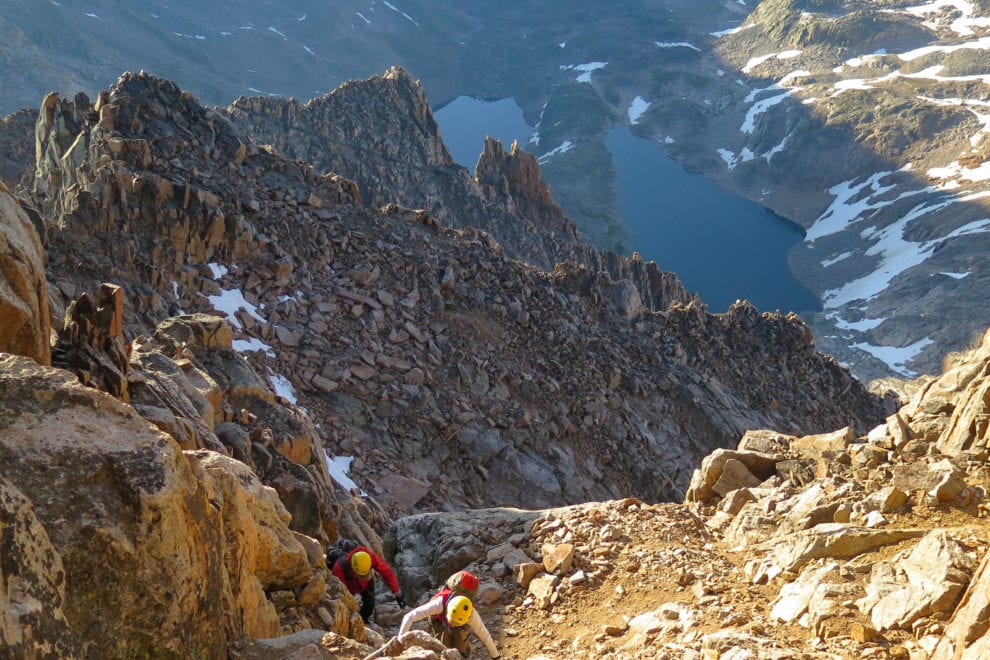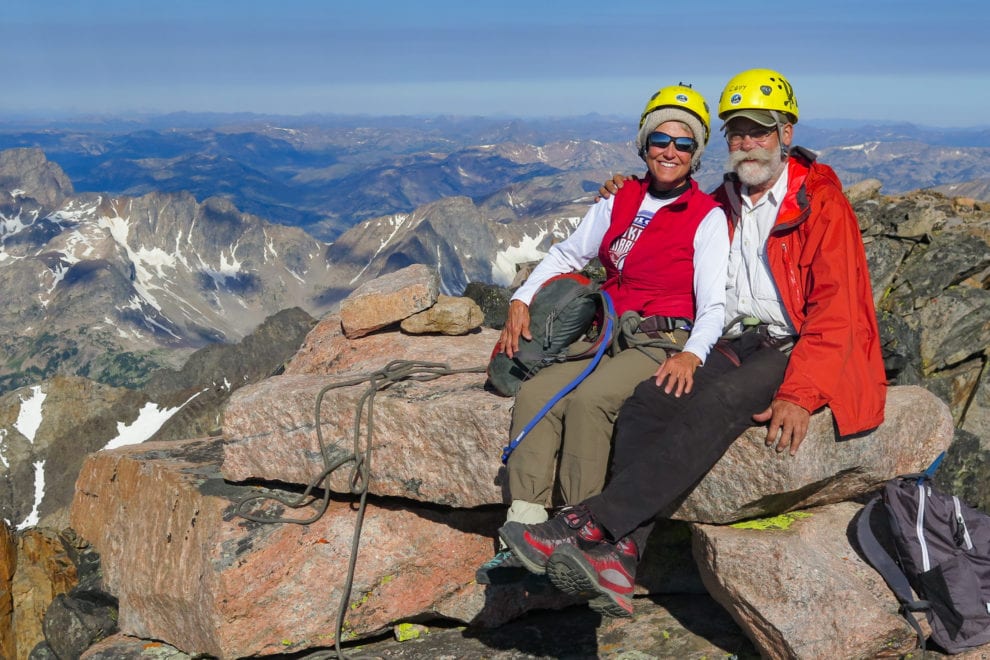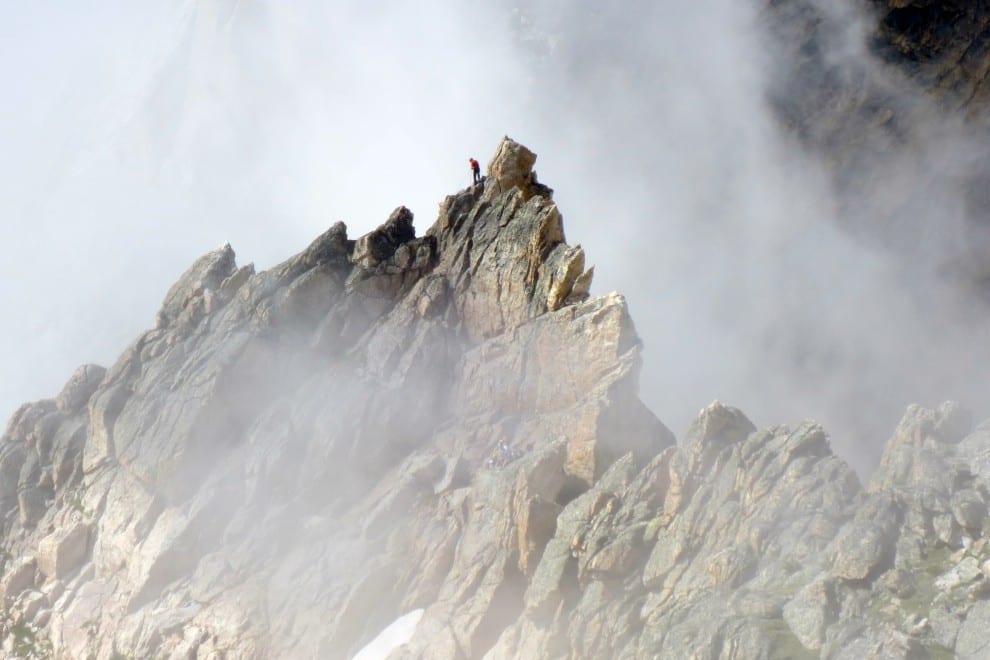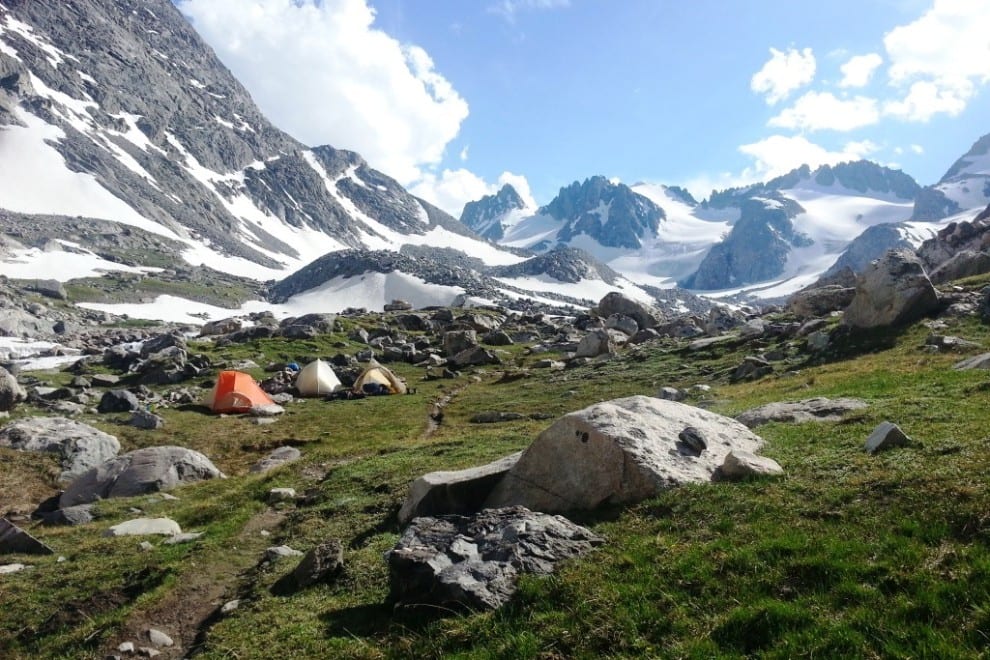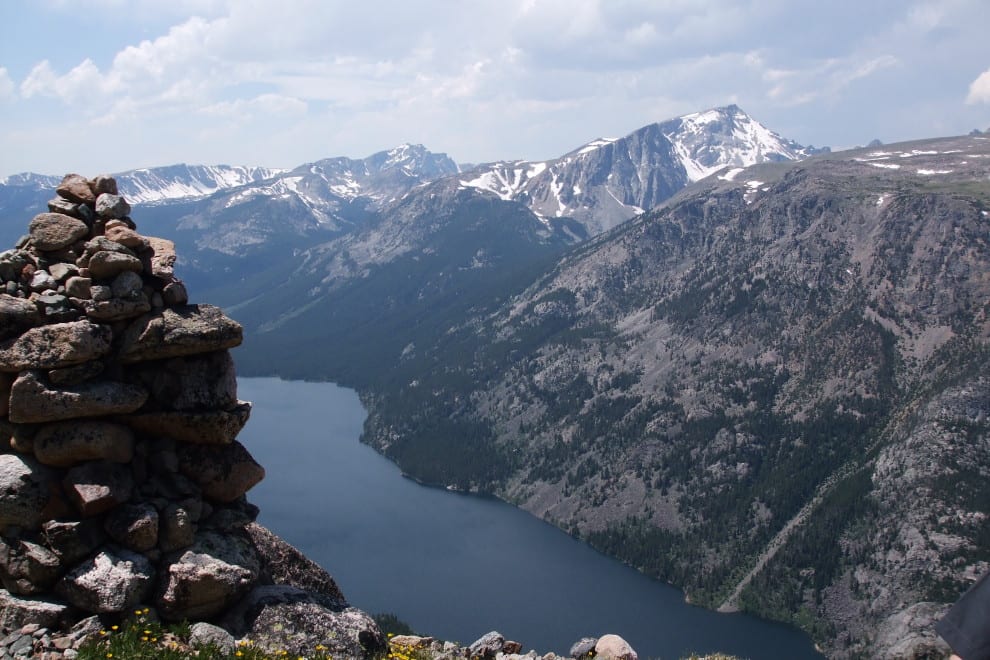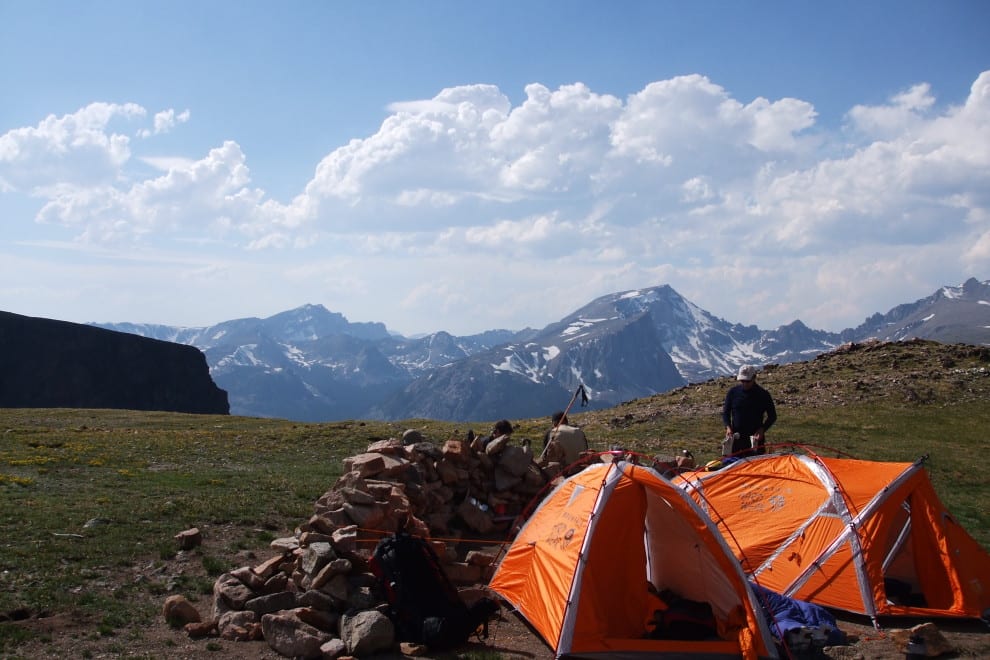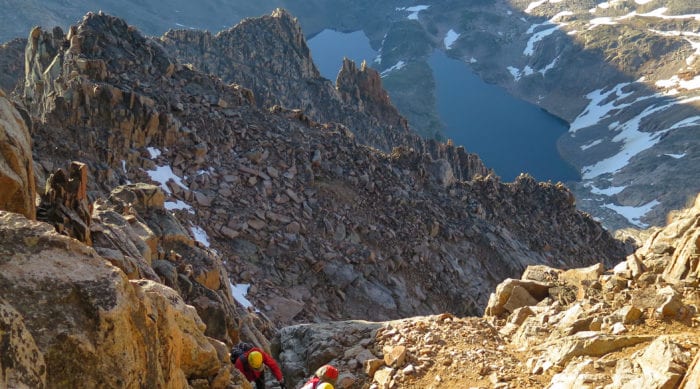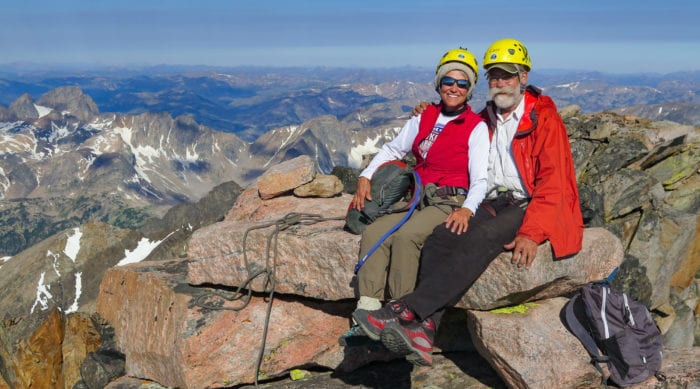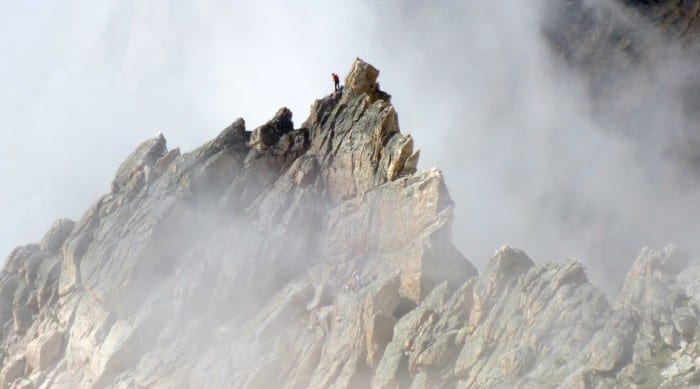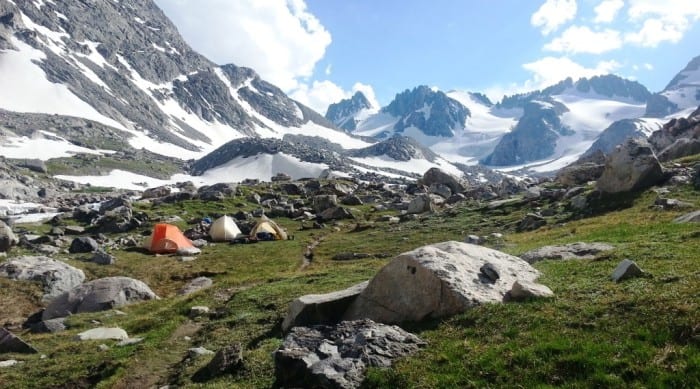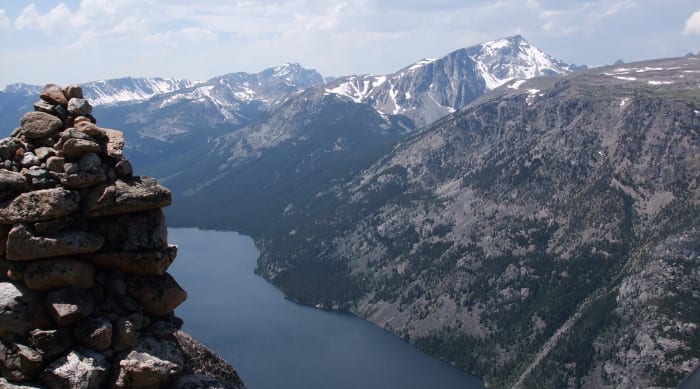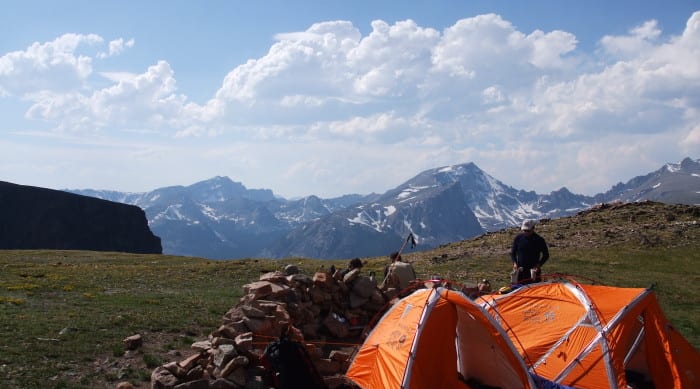- Photo by: Colin Wann

- Photo by: Colin Wann

- Photo by: Guide Kenny Gasch

- Photo by: Guide Kenny Gasch

- Photo by: Guide Kenny Gasch

- Photo by: Guide Kenny Gasch

Overview
Granite Peak, with an elevation of 12,803″, is Montana’s highest peak. This formidable mountain is located in the heart of the remote and scenic Absaroka-Beartooth Wilderness, just north of Yellowstone National Park. It is a challenging climb requiring rock and snow mountaineering skills and has a lengthy and strenuous approach. Granite Peak is considered by many to be the most difficult high point summit after Denali.
The Mountain Guides Montana is the oldest and most experienced guide service serving those who wish to climb Granite Peak. We offer our standard 5-day trip; we also have 6-day trips for those wishing to add a day, for weather reasons, fishing, or for a little more acclimatization and rest time.
Types High Points - Mountaineering - Multi Day Trips - Rock Climbing
Season Summer - Fall
Miles 25
Elevation 12,803'
Elevation Gain 6800'
Trip Planner
Itinerary
Typically, Granite Peak climbs meet at 8:00 am in Red Lodge, Montana, with a gear check with your guide as well as distribution of group gear. From there you’ll proceed to the West Rosebud (Mystic Lake) trailhead and hike to Mystic Lake to set up camp and cover technical climbing skills on rock near the lake.
From Mystic Lake our first day’s hike takes us to Camp 1, located approximately 7+ miles from and 4,200 ft. above the trailhead. Camp 1 is located at the very N.E. corner of the unique Froze-to-Death Plateau. Day 2 is much easier with only 3+ miles to hike and 1,600 ft. to gain. Camp 2, located at tempest Col, gives us an awesome view of Granite Peak’s North face, and situates us for an optimal approach on summit day. Weather providing, day 3 is summit day.
The East Ridge of Granite Peak is the most popular approach on summit day. Snowfields (boulders later in the season) and scrambling lead to the infamous “snowbridge”, a narrow ridge with steep couloirs falling away on both sides. Above, scrambling and 5.4 rock climbing interspersed with comfortable ledges lead to the summit. The descent uses the same route, usually requiring 2 or 3 rappels. On the final day lighter packs and downhill hiking make attaining the trailhead reasonable.
The itinerary for the 6-Day ascent of Granite Peak is exactly the same as the 5 day with one day built in for weather, acclimatization, or just one more fun day in the spectacular Beartooth mountains.
Typically, Granite Peak climbs meet at 8:00 am in Red Lodge, Montana, with a gear check with your guide as well as distribution of group gear. From there you’ll proceed to the West Rosebud (Mystic Lake) trailhead and hike to Mystic Lake to set up camp and cover technical climbing skills on rock near the lake.
From Mystic Lake our first day’s hike takes us to Camp 1, located approximately 7+ miles from and 4,200 ft. above the trailhead. Camp 1 is located at the very N.E. corner of the unique Froze-to-Death Plateau. Day 2 is much easier with only 3+ miles to hike and 1,600 ft. to gain. Camp 2, located at tempest Col, gives us an awesome view of Granite Peak’s North face, and situates us for an optimal approach on summit day. Weather providing, day 3 is summit day.
The East Ridge of Granite Peak is the most popular approach on summit day. Snowfields (boulders later in the season) and scrambling lead to the infamous “snowbridge”, a narrow ridge with steep couloirs falling away on both sides. Above, scrambling and 5.4 rock climbing interspersed with comfortable ledges lead to the summit. The descent uses the same route, usually requiring 2 or 3 rappels. On the final day lighter packs and downhill hiking make attaining the trailhead reasonable.
Pricing
6-Day Granite Peak Climb: $3600 private 1:1; $3000 pp/ 2:1; $2700 pp/ 3:1group
5-Day Granite Peak Climb: $3000 private; $2500 pp/2:1 ; $2250 pp 3:1 group
Price includes breakfasts and dinners (i.e., evening meal) while in the backcountry, technical climbing gear, tent and group cooking gear. *** PORTERS HIGHLY RECOMMENDED. Price does not include equipment drop/portage and shuttle fees.
Group pricing is for 2 – 3 people on a trip. Please note that trips must reach minimum # of people.
Training is required for all guests without extensive traditional multi-pitch rock climbing experience.
Private trips cannot be booked directly online based on scheduling, please click here to inquire about specific dates for a private trip. Please read through our policies by visiting this page.
Schedule
The Mountain Guides Montana schedules Granite Peak trips in July and August. However, late June and early September can also be an excellent time. We are happy to schedule a trip for your group any time during the season. We have pre-set dates for Granite Peak trip but we are able to create custom itineraries when needed.
Equipment
Equipment
JHMG supplies camping permits, tents, stoves, and climbing gear as needed. Clients are welcome to use their own climbing gear but please coordinate with our office. JHMG supplies breakfasts and dinners; clients are responsible for trail food, lunches and beverages.
Keep in mind the strenuous wilderness character of Granite trips; gear should be light and in good repair. Minimize luxury items.
Footwear traditionally raises questions. Typical conditions through July require boots sturdy enough for snow climbing and crampons. Plastic double mountaineering boots are not suitable- they are too bulky and heavy. A mid-weight leather or kevlar boot is far better. In late July and August, light hiking boots and approach shoes work well.
Packs need to be large enough for personal gear plus your share of the group gear and food. If you plan to use an external frame pack you will also need a day pack for the climbing day because the frame packs are impossibly unwieldy for rock climbing.
High-tech rain gear made of breathable fabric is great but is often very expensive. Rain gear made of coated nylon will do the job for much less cost.
Porters are strongly encouraged and are available starting at $275.00 per day. The terrain is not suitable for horse packing.
Footwear
Objective Dependent – Scarpa footwear is available at Jackson Hole Mountain Guides for rent. JHMG also carries a selection of rock shoes for rent.
- Sticky Rubber Approach Shoes: required for all mid-summer climbs (mid-July through Sept). Guide Pick: Scarpa Crux (Available for rent)
OR
- Mountain Boots: Most trips before July 15 and all Gannett Peak Climbs, require a crampon-compatible mountain boot – Guide Pick: Scarpa Zodiac Tech (Available for rent)
- Rock Shoes for technical rock routes (Available for rent)
- Socks: 2-4 pairs: sized for your boots and blister prevention
Upper Layers
- Synthetic/Wool Long Underwear Top
- OR
- Synthetic/ Wool Sun Hoody
- Synthetic T-shirt
- Insulating Jacket: lightweight fleece or synthetic
- Soft Shell: fleece or pile
- Rain Jacket: waterproof/breathable with hood.
Bottom Layers
- Synthetic/Wool Long Underwear Bottom
- Hiking Short or Pant for approach
- Synthetic Climbing Pant
- Rain Pant
Accessories
- Hat: lightweight to medium-weight warm hat – sleek enough to be worn under a helmet
- Gloves: BRING TWO PAIR – one lightweight to medium weight pair – synthetic or fleece material. If snow route, shell also recommended.
On the trail
- Alpine Climbing Pack – Internal frame only. 45 to 5O L for 2 or 4 day trip. Large enough to fit all your personal gear plus ten pounds of food and water.
- Sleeping Bag
- Water Bottles (2-3 L/Qt.) or H2O hydration system
- Water Treatment – Steripen or other
- Closed-toed camp shoes (optional)
- Stuff Sacks: zip lock bags
- Dark Sunglasses
- Extra Contact Lenses
- Sun Hat or Visor
- Sunscreen (35+SPF)
- Lip Balm
- Headlamp and Fresh Batteries
- First Aid – minimal: blister care, analgesic, etc.
- Lunch, snacks & drink mix.
- Misc Items: minimal: light knife, camera,
bandana, camp suds, washcloth, etc.
Some trips require (please inquire with JHMG):
- Sleeping Pad: Closed-cell foam or Thermarest
Recommended & Optional Items
- Trekking Poles
- Camera and batteries, spare memory card
- Insoles: custom or aftermarket
- Insect Repellent (Ask the office if this is necessary)
- Headnet (Ask the office if this is necessary)
- Camp Shoe – lightweight
Cold Weather Considerations:
Early and late-season temperatures require warmer clothing. You may consider additional clothing if you get cold easily or if it is unusually cold or windy.
- Buff or neck gaiter
- Extra down vest or jacket
- Expedition weight long underwear
- Extra gloves
**The Mountain Guides supplies all the rock climbing gear, harnesses, helmets, locking carabiners & belay/rappel devices, crampons, and ice axes. However, you are welcome to bring your own equipment. Please coordinate with our office for gear checks. Backpacks, rock shoes, and boots can all be rented & purchased in our Jackson office.
For your safety and comfort, bring synthetic and or natural fiber clothing for insulation. Cotton
is NOT recommended and down must be kept dry. Clothing should be able to layer without
encumbering movement.
Travel
Best Airports:
We recommend that clients fly into the area the day before the trip begins. This makes sure that everyone is ready to go for Day 1 and we are not waiting on plane delays.
Billings-Logan International Airport
Bozeman-Yellowstone International Airport
Pre-trip Accommodations:
We recommend that clients stay in Red Lodge Montana the night before the trip leaves. There are several options when searching lodging in Red Lodge Montana.
Transportation:
You will need to rent a vehicle to get from Bozeman or Billings to Red Lodge. This is about a 2 hour drive. You will not be able to rely on TMGM for any transportation.
Beartooth Wilderness trips, climbs, and classes are based out of Cody, WY, unless other arrangements have been made with your guide. The closest airport is Yellowstone Regional Airport. Please plan on having your own local transportation; it’s a good idea to reserve rental cars as early as possible. For significant climbs, please plan on arriving a day or two before your departure date to acclimatize. There are numerous accommodations and camping options near the Cody office. Jackson Hole Mountain Guides provides most of the food other than drinks and lunch/snacks for multi-day trips (not classes); our office will fill you in on the details before your trip. All supplies must be purchased in town before the trip.
VIEW PDF
FAQS
Why is the first day of the trip the hardest?
It's the most elevation gain and the greatest distance of any day with fully loaded packs.You gain approx. 4,100 ft. in elevation and hike just over 7 miles.
If the second day is much shorter distance and elevation gain and we reach our high camp early enough, why not just go for the summit?
The peak looks much closer from our high camp on Tempest Col than it is. We structure our trips for success and an early arrival at high camp enables everyone to rest, hydrate, eat, and acclimate. Tempest Col is 12,000 ft. and a semi-rest day at the col makes the summit bid the following day much easier and enjoyable and increases our chances for success.
How long is a typical summit day?
It all depends on a number of things like the size of your party, route conditions, weather, how fast one moves, etc. Lots of variables to consider. A typical summit day is 10 hrs. with an average group. My personal records are 6 hrs. 39 mins. on the shortest to 14 hrs. 45 mins. on the longest.
If we move fast on summit day and get back to high camp in time can we hike part of the way out that same day?
Possibly. Your guide will determine that once you get back down off of the summit. If the weather is stable and folks are still fairly fresh a move back down to Camp 1 is very feasible. Once high camp is broken you need to be sure you can get back off of the plateau without getting caught in bad weather or having someone bonk. The plateau is very exposed and no place to be caught out on.
What's the availability of water like on this trip?
There are good and ample water stops all along the way. The water source at Tempest Col, our very highest camp, can be a little elusive late in the season if it's a very dry year but for the most part obtaining fresh water is not an issue. We filter all of our water. You are welcome to bring your own filter however our guides carry water filters and some carry Steri-Pens as well.
If we book a 5 day trip and summit day 3, can we hike out a day early.
Absolutely! Most folks do. It's always best to take advantage of good weather in the high mountains.
Talk To Us
Here you’ll find online tools and information about joining us for a trip of a lifetime! To sign up for a trip, or if you have any questions, please call us. Listed on the left side of these pages are links that you may find useful, including printable forms and policies concerning a trip with TMG. We encourage ALL prospective climbers to read our Preparation advice. Our office can help place you with others who are looking to climb.
